
Surveys
DJC.COM
July 12, 2001
Bringing a city stream back to life
URS Corp.
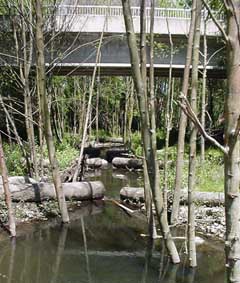
A series of step pools raise the water level as it passes under the Nevada Street bridge. |
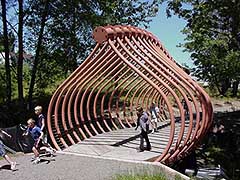
Photo by Mike Morse/Seattle Public Utilities Fish skeleton bridge designed as part of the site artwork by Lorna Jordon. |
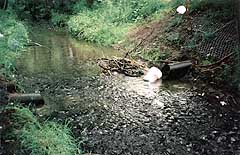
Photo by Doug Sovern/URS Corp. The channel under the Nevada Street bridge prior to stream improvements. |
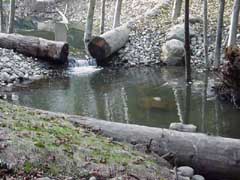
Photo by Mike Morse/Seattle Public Utilities A timber step down near the Nevada Street bridge. |
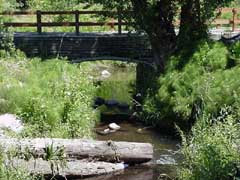
Culverts over Longfellow Creek were replaced by culverts topped with pedestrian bridges. |
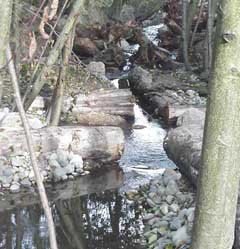
Photo by Mike Morse/Seattle Public Utilities The base flow stream narrows and deepens here to protect fish while spawning and migrating. Also provided is clean spawning gravel. |
The stream rehabilitation for the Longfellow Creek Yancy Street project is an integrated planning and design project on about six acres of city-owned land between Yancy Street and Genesee Street.
The project was completed for Seattle Public Utilities on land owned by the Seattle Department of Parks and Recreation.
This project aggressively reclaimed a ruined urban stream and now provides secure, life-cycle habitat for salmonid and other aquatic species in urban open space.
The stream rehabilitation concepts were an integral part of an urban site and corridor planning that has converted a blackberry-choked stream and site to high-quality urban open space.
The “new” open space has been adopted by the neighborhood and is now filled with people.
The lower segment was completed in 1999, while the remainder of the stream rehabilitation was completed in 2000. All of the in-stream facilities have prospered from several large storm events and spawning of returning coho was successful in both 1999 and 2000.
The lower segment provided excellent rearing habitat for 1999 and 2000.
An aesthetic design is featured to encourage the public to use and feel ownership of this urban open space. Inclusion of public art increases the sense of value in the site and enhances feels of public ownership.
Future site projects will add a dragonfly pavilion and a fern amphitheater.
The riparian corridor completed in this project both supports the theme of the public art and aesthetic design, but also is the unifying feature within urban open space site.
Two bridge crossings of Longfellow Creek are specifically created in a form, which supports art and aesthetic themes.
The bridges permit controlled public access to the creek while maintaining privacy for the fish and aquatic environment. The “fish bone” bridge uses a contoured steel pipe shell and varying width and height dimensions to convey an image of a fish bone structure.
Near the future fern amphitheater located near Genesee Street, the basic structure of a sweeping pedestrian bridge was constructed. When completed in the subsequent art construction phase, the bridge will gracefully convey pedestrians over Longfellow Creek to the cozy confines of the fern amphitheater.
Project Team:
Seattle Public Utilities —
Owner, permits, design input, monitoring
URS —
Prime consultant, civil
design, specifications,
bidding assistance,
construction monitoring
Hough Beck & Baird —
Site planning, site design, upland planting
Taylor Associates —
Fish biology, monitoring
Lorna Jordon —
Artist
Doug Sovern is a professional engineer and senior project engineer at URS Corp.
Other Stories:
- Pesticide-free parks teach new lessons
- Construction faces new foe: toxic mold
- Water metering: the debate trickles on
- Studies sniff out Tacoma smelter plume
- Tree investment brings cities many happy returns
- From wood preservation to site remediation — the Cascade Pole cleanup
- New rules for birds, bogs and bulldozers
- Isolated wetlands ruling creates confusion
- Environmental metamorphosis on the Duwamish
- Mitigation banks balance habitat, development
- New Pin Foundation minimizes site impacts
- Knitting a trail of green
- Stormwater problems? Put a LID on it
- More brownfield incentives in the pipeline
- SEPA document trends since GMA and regulatory reform
- Helping environmental groups to get wired
- Shedding light into the permit ‘black hole’
- Frequently asked ESA questions
- Muddy waters: The new 4(d) salmon rule
- Global climate change starts at home
- At EPA, next 4 years won’t be boring
- Dams vs. fish? Mediate it!
- 'House calls' help firms to conserve
- Building a greener future on Bainbridge
- Power users, producers turn toward the sun
- Seattle goes climate neutral
- Bamboo’s popularity shoots up
- Tiny town recycles Goliath proportions
- MTCA revisions take effect Aug. 15
- Environmental education: Knowing what’s in your backyard
- Bear Creek roars again
- UW Bothell — a wetland lesson in the making
Copyright ©2009 Seattle Daily Journal and DJC.COM.
Comments? Questions? Contact us.